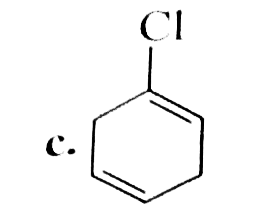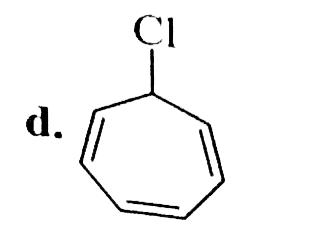Which of the following compounds will give curdy precipate with AgNO3 solution?




The correct Answer is:d
To determine which of the given compounds will give a curdy precipitate with AgNO₃ solution, we need to identify which compound can easily release chloride ions (Cl⁻). The chloride ions react with silver nitrate (AgNO₃) to form a white precipitate of silver chloride (AgCl).
1. Understanding the Reaction:
- Silver nitrate (AgNO₃) reacts with chloride ions to form silver chloride (AgCl), which is a white curdy precipitate.
- The key to this question is identifying which compound can release chloride ions.
2. Analyzing Each Compound:
- Compound A: This is an aryl halide. In aryl halides, the carbon-chlorine bond has partial double bond character due to resonance. This means that the chlorine is not easily released as a chloride ion. Therefore, it will not give a curdy precipitate with AgNO₃.
- Compound B: This compound forms a vinylic carbocation upon the removal of chloride. Vinylic carbocations are unstable due to the high s-character of the sp² hybridized carbon. Thus, this compound also does not easily release chloride ions and will not form a precipitate.
- Compound C: Similar to Compound B, this compound also forms a vinylic carbocation upon the removal of chloride. It shares the same instability issues and therefore will not release chloride ions easily.
- Compound D: This compound, when fluorine leaves, forms a stable carbocation due to its aromatic nature. Aromatic compounds are highly stable and can easily release chloride ions. The presence of aromaticity allows for the formation of a stable structure, making it likely to react with AgNO₃ and form a curdy precipitate of AgCl.
3. Conclusion:
- After analyzing all the compounds, we conclude that Compound D is the only compound that will give a curdy precipitate with AgNO₃ solution due to its ability to easily release chloride ions.
Final Answer:
Option D will give a curdy precipitate with AgNO₃ solution.
- Silver nitrate (AgNO₃) reacts with chloride ions to form silver chloride (AgCl), which is a white curdy precipitate.
- The key to this question is identifying which compound can release chloride ions.
- Compound A: This is an aryl halide. In aryl halides, the carbon-chlorine bond has partial double bond character due to resonance. This means that the chlorine is not easily released as a chloride ion. Therefore, it will not give a curdy precipitate with AgNO₃.
- Compound B: This compound forms a vinylic carbocation upon the removal of chloride. Vinylic carbocations are unstable due to the high s-character of the sp² hybridized carbon. Thus, this compound also does not easily release chloride ions and will not form a precipitate.
- Compound C: Similar to Compound B, this compound also forms a vinylic carbocation upon the removal of chloride. It shares the same instability issues and therefore will not release chloride ions easily.
- Compound D: This compound, when fluorine leaves, forms a stable carbocation due to its aromatic nature. Aromatic compounds are highly stable and can easily release chloride ions. The presence of aromaticity allows for the formation of a stable structure, making it likely to react with AgNO₃ and form a curdy precipitate of AgCl.
- After analyzing all the compounds, we conclude that Compound D is the only compound that will give a curdy precipitate with AgNO₃ solution due to its ability to easily release chloride ions.
Option D will give a curdy precipitate with AgNO₃ solution.
Topper's Solved these Questions
- AROMATIC COMPOUNDS AND ALKYL AND ARYL HALIDES BOOK - CENGAGE CHEMISTRY ENGLISHCHAPTER - AROMATIC COMPOUNDS AND ALKYL AND ARYL HALIDES EXERCISE - Exercises Assertion-Resoning Type
1 Videos
- AROMATIC COMPOUNDS AND ALKYL AND ARYL HALIDES BOOK - CENGAGE CHEMISTRY ENGLISHCHAPTER - AROMATIC COMPOUNDS AND ALKYL AND ARYL HALIDES EXERCISE - Exercises Assertion-Resoning
11 Videos
- AROMATIC COMPOUNDS AND ALKYL AND ARYL HALIDES BOOK - CENGAGE CHEMISTRY ENGLISHCHAPTER - AROMATIC COMPOUNDS AND ALKYL AND ARYL HALIDES EXERCISE - Exercises Single Correct Answer Type
28 Videos
- APPENDIX INORGANIC VOLUME 2BOOK - CENGAGE CHEMISTRY ENGLISHCHAPTER - APPENDIX INORGANIC VOLUME 2EXERCISE - Short Answer Type
179 Videos
- BIOMOLECULESBOOK - CENGAGE CHEMISTRY ENGLISHCHAPTER - BIOMOLECULESEXERCISE - Exercises Archives (Analytical And Descriptive)
8 Videos
Similar Questions
Knowledge Check
Which of the following compounds will react with NaHCO3 solution to give sodium salt and carbon dioxide?
AAcetic acidBn-HexanolCPhenolDboth (b) and (c).Which of the following compounds will react with NaHCO3 solution to give sodium salt and carbon dioxide?
AAcetic acidBn-HexanolCPhenolDboth (b) and (c).Which of the following compounds will react with NaHCO3 solution to give sodium salt and carbon dioxide?
AAcetic acidBn-HexanolCPhenolDboth (b) and (c).
Which of the following compounds will form the precipitate with aq.AgNO3 solution most readily?
View SolutionWhich one of the following is likely to give a precipitate with AgNO3 solution ?
View SolutionWhich one of the following is likely to give a precipitate with AgNO3 solution ?
View SolutionWhich of the following does not give yellow precipitate with AgNO3 ?
View SolutionWhich of the following does not give a precipitate with alcoholic AgNO3 ?
View Solution
